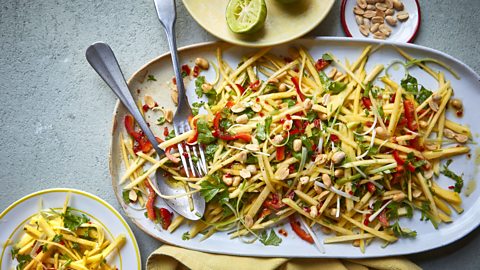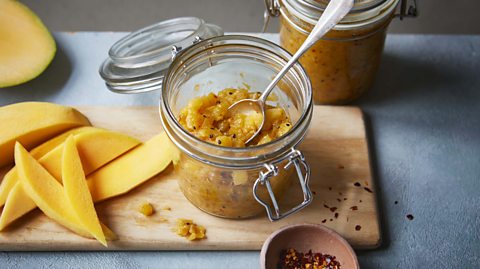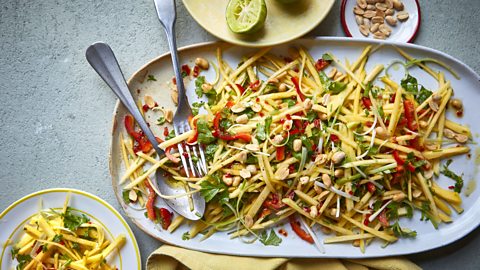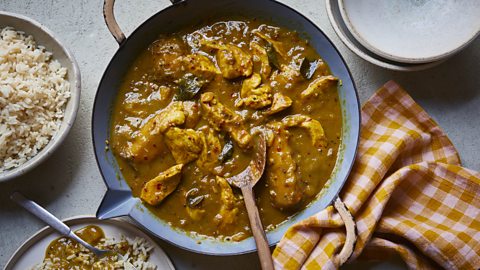It‚Äôs officially the season of the ‚Äėking of fruits‚Äô ‚Äď here‚Äôs how to use it
While delicious eaten raw, these versatile fruits are also great for cooking with, lending their distinctive flavour to both sweet and savoury dishes. Here's how to make the most of them this summer.
By Romy Gill

Known as due to their juicy, tropical flavour and nutritional benefits, mangoes played a special part in my childhood.
When I was young, living in West Bengal in India, I’d eat three or four a day when they were in season. This is between March and August, although they’re usually at their very best from May to July.
My dad would pluck the mangoes from a tree and drop them into a bucket of water to cool them down. Then, we’d suck the juice straight from the fruit, taking our tops off first as we knew just how sticky they could be. They also bring back memories of my mum in the kitchen turning them into mango pickle to serve with our meals. They were a staple part of our diet.
Mango chutney
Romy's mango chutney recipe is inspired by the one her mum used to make

As you can tell, mangoes fill me with nostalgia. So much so that several years ago I returned to India, travelling through various states trying to find different varieties.
On this trip, when visiting Lucknow, I travelled north of the city and was lucky enough to be granted an audience with Haji Kalimullah Khan (Kaleem Ullah Khan), known as ‚ÄėMango Man‚Äô. He achieved fame by grafting a mango tree to grow over 300 varieties. Hundreds of awards and photographs of him with dignitaries were hung on the walls and he talked to me about them all, proud of his life‚Äôs achievements.

What to expect from the most famous varieties
There are over grown in India and there‚Äôs a huge amount of difference between them in terms of flavour and texture ‚Äď for example, some have lots of stringy fibres whereas others have none.
When I was growing up, vendors would travel to our town from different states throughout mango season, selling their region’s varieties. My dad would be told when each type would arrive and I’d be particularly excited when the sweet, soft and juicy Langra variety, as well as the Kesar with its gentle acidity were imminent.
Alphonso mango tart
This tart uses alphonso mangoes. If you can't get hold of them, go for tinned alphonso pulp which is readily available

While in years past it’s been hard to find Indian mango varieties here in the UK, that’s thankfully no longer the case. In fact, just over the last few weeks I’ve picked up three different varieties from three different national supermarkets.
Of course, if you go to a greengrocer or a specialist shop which sells Indian produce, you‚Äôll find even more varieties and they‚Äôll taste different to the two types most often found in supermarkets ‚Äď the Tommy Atkins, which is sweet with a slight tart note, and the Kent, which has a rich and sweet flavour with some sourness.
Here’s what the most popular Indian mango varieties are and what you can expect from them:
| Mango | Grown in | What to expect |
|---|---|---|
| Kesar | Junagadh and Gujarat | Distinctive sweet flavour |
| Alphonso | Ratnagiri and Maharashtra | India’s favourite mango, it’s sweet like a very ripe apricot or nectarine |
| Chausa | Uttar Pradesh | No fibres and aromatic flavour |
| Langra | Uttar Pradesh | Fibrous and sweet and fibrous but with a tangy aftertaste |
| Banganpalle | Andhra Pradesh | The most sought-after late season mango in the region. They have firm, sweet flesh with little fibre |
| Totapuri | States throughout south India | A chewy texture and a piquant flavour |
| Neelam | Grown all over India | Smaller than other varieties and known for being sweet |
| Dasheri | Northern India and Uttar Pradesh | Tangy with citrus flavours and a hint of honey. Very juicy |
| Badami | Karnataka | Sweet and known as Karnataka’s Alphonso for their beautiful flavour |
Choosing the right mango
The type you choose will depend on the texture you need and the level of sweetness you want in your recipe: mangoes with softer, less fibrous flesh are great for pulping, while those with firmer flesh work better in recipes where the fruit needs more bite. Some recipes will call for ripe mangoes while others, like my mango salad, work better with unripe mangoes.
Mango salad
A refreshing mango salad is a great way to use the fruit when it's unripe

To test for ripeness, smell the mango first; if it smells sweet it‚Äôs likely to be ripe, and if it smells bitter or sour it‚Äôs likely unripe (or bad!). The way to tell whether it‚Äôs unripe is if it‚Äôs still very hard. Avoid picking a bad one by checking the skin. It should be smooth and firm ‚Äď wrinkled skin could suggest that a mango is past its best. Finally, apply gentle pressure to the skin: if it gives slightly when you squeeze it, it‚Äôs ripe.
Cooking with mangoes
Mangoes are perfect to eat just as they are, but when you do cook with them you can expect beautiful dishes. It’s worth experimenting with both sweet and savoury recipes.
Kesar mango and chicken curry
There are several varieties which are great for making mango curries, including sweet Kesar

As I‚Äôve mentioned, different types lend themselves to different dishes ‚Äď although there are a few all-rounders. For instance, Kesar mango is versatile and as such you could chop it into chunks and add to a curry, blend the pulp and add it to a drink or grate it into rice pudding. Banganpalle mangoes, meanwhile, are great for turning into a refreshing salad with a squeeze of lemon juice and mint. And when it comes to the ever-popular alphonso, you could get a tin of its pulp and use it to make a dessert such as a tart or pie.
If you have a sour, unripe mango, it will be perfect for turning into a tangy chutney or pickle, or you could make aam papad (fruit leather). You mash it to a pulp, spread it onto a baking tray and oven bake.
Whatever you end up making, you can be sure that it will bring you joy and sunshiny flavour, just as mangoes have done for me both as a child and an adult.
Now make
Originally published June 2023